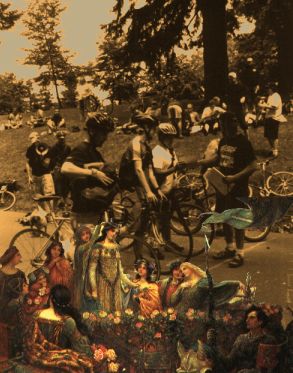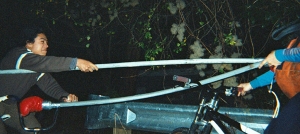 |
 |
Chunk DCLXVI
and DBB
Gladiator? Yes, yes, he was. |
 |
 |
SMALLER VIDEOS: IS vs clown, TO wins, RZ vs KO (first link)
| ...a cyclist was expected to be gentle and faithful to his lady, fearless in battle and tournament, courteous and merciful to a defeated enemy and honorable in everything. |
|
John Hampden, from "The Days of
Chivalry" |
---or something like that...
|
Are you
worthy? |
|
|
The words "championship" and "joust" are often used interchangeably. Strictly speaking "joust" describes single combat between two riders. "Championship" refers to mounted combat between parties of knights (the main race, 10-9?), but also is used to refer to the whole freakin' potato. The first written tournament guidelines are usually credited to a Frenchman named Geoffroi de Purelli in 1066. Unfortunately, he was killed at the very tournament for which he made the rules. Ouch. So, hey, I don't make the rules, ok? Messenging, as a regular occupation for a gentleman or lady, had many disadvantages. Although it was necessary, from time to time, to go to work in the service of one's employer, this included the disagreeable prospect of death or injury by SUV or road turtle, or dysentery via extra-old microwaved take-out or excessive consumption of dollar pints or too many Dick's burgers, and of course sleeping on the cold, stony ground or baking in one's bike helmet, beneath one's bag, under a blazing sun. There was excitement and renown to be won in messenging, but just as much renown could be won, at far less inconvenience, in the tournament of peace. |
 |
|
Obviously, there was a direct conflict between the Christian ideal of monogamy and what can only be described as polite aristocratic adultery, which quickly brought the wrath of the Church upon all who participated. Ooooh, the wrath of the church... The French excelled in this department, whereas in England, a tournament was regarded more as serious training for war. English contests became so savage that the Church of England eventually forbade the Christian burial of those killed in tournaments. "Those who fall in tourneys will go to hell", scolded one monk. Right, and I'll never find a cemetery to sleep in. As if I'll ever die. Tournaments were generally viewed with disapproval by the Church because they distracted the knights from the crusades, and by the state because of the unwarranted loss of life. Popes preached against them and Kings regarded them with unease, nervous about the potential threat a large gathering of military forces could impose on their politically unstable regions. Both were quite powerless to stop them. The knights' enthusiasm was already too great, and the powers-to-be were forced to extend a grudging tolerance to the new sport. The Statute of Arms for Tournaments, established in 1292, helped curtail the bloodshed at tournaments. Under this edict all Knights were automatically considered gentlemen, rather like the Congressional edict in the United States that makes all armed forces commissioned personnel "officers and gentlemen". They were required to abide by the ideas of chivalry and fair play, thus reducing the abhorrence of the church considerably. Nobody really wants to get hurt. At the end of the twentieth century, when tournaments ceased to be ill-conceived and never carried out West-Side Story style rumbles with no holds barred, they became organized spectacles, subject to accepted conventions and often fought with blunted weapons. The rise of the "PVC pipe with boxing glove" seemed safety-conscious enough, as well as silly to a snicker. To kill a man in a tournament was considered wrong - or, at the very least, unfortunate. And then there's hospital bills, insurance, ambulances, a general besmirching of the good name of Bicycle Jousting... For killing a bike there was no excuse. One doesn't hit the steed, thankyou, some things are just WRONG. The knight's object became one of knocking off their bikes as many opponents as possible, and in the process, breaking as many lances as possible; obviously the more lances a knight broke, the greater must have been the force of his charge and the higher his level of wheelmanship. Lately, lance construction seems to be impervious enough to breakage that falls are more common, if people aren't being sissies about taking a whallop in the chest. Besides, we only have so many lances. As of late, skinny (and too light for some's tastes) bamboo has been suggested for the smashingest of good times. |
--There were three kinds of bicycle championships prior to the 17th Century--
 |
MELE… or
TOURNEY PROPER
- popular in the twelfth and thirteenth century.
This form was the most brutal and costly in lives. All participants, upon
hearing the charge, promptly crashed onto the tournament field and
proceeded to de-bike all others by any method at hand until a winner was
determined. All weps. Beware the maul and the larger of the
sledges. Maces and flails have been discussed. Whooop-de-freakin'-doo! Them folx is nuts! Haven't had the meleť yet in SeaWA. Also known as "bike polo" when a ball is used. |
 |
 |
INDIVIDUAL JOUST - an encounter with lances between two riders. The rules were simple. If a combatant struck the bike he was disqualified. A nice square hit to the chest, or maybe a helluva belly shot, a tricky shoulder boomp, all are choice. "Not in the face" and genital shots are frowned heavily upon. A low partition wall separating contestants was introduced in about 1420 strictly as a measure to reduce injury to cycles. Barriers might prove ill-treating to rider ribcages, and negate the silly running in circles that most oft drips long with hilarity. |
| PRACTICE TOURNAMENT - Involved very little ceremony and few rules. Practice targets long were provided by either a quintain or rings. The quintain was a wooden target mounted on a horizontal pole at which the rider aimed his lance. If the target was struck accurately, it would swing harmlessly aside; if struck off center, the weighted arm swung around with enough velocity to unseat the knight via swift ass-kick. The other form of jousting in the practice tournament was "riding at the rings", the surviving form of jousting with which we are most concerned about being so weak in the pants. A ring was suspended on a cord, which was to be carried off on the tip of the knight's lance. Can you say sissy? Both the quintain and the ring joust were exercises that developed accuracy skills. Most Dead Babies already possess these. These skills became increasingly important as individual jousts gained popularity. |  |
 |
Furthermore, it is probable that riding at the rings was perceived also as a display of chivalric romance. (Um..., duh?) Winning knights were awarded customary "golden rings" along with kisses, in a formal and elaborate prize-giving ceremony by the ladies of the court, who had rapidly become central to the whole ideal of knighthood during the fourteenth century. Hot damn! |
 |
|
|
somewhat blatantly, and with only this little line-o-shame, thieved from someplace else until they moved it once then moved it again over the period of a few short years to here. sorry, but I like to learn from my elders. 15%? or, satire? I mean, I changed up the pix...
the greatest jousting movie I know of at this time is a whopping 68 Megs of 12+ minutes HERE. tell that guy to stare AWAY from the sun.
|
©ABCdzyne 03.06.06 |


 ouble-O-One, the Double Small, the
Schwinnivega, Nishigun, Shoshiki, Paul's Bunion -- the very names ring with chivalry. The
question then is "What is Chivalry?". The word
comes from chevalerie which derives from cheval,
French for "tallbike." And the tallbike is what set the knight
apart. Remember Richard III's cry in Shakesgeare
"My kingdom for a tallbike." Odd bicycle fiends organized into
clubs, spawning freakish steeds of the draft-type size and strength to carry the
ever increasing weight of an armor-bearing rider, and heavy, goofy
lances. Toeclips, which had been brought from the east in about
the eighth century, stabilized this armored,
lance-bearing warrior astride his gigantic steed. Before toeclips, you clung on as best you
could, happy with your rat-traps or SPD's. Somewhat happier you could bail
without actually killing yourself. The shock value of crazy folks on
tallbikes was a weapon of great impact,
indeed a military revolution by bicycle.
ouble-O-One, the Double Small, the
Schwinnivega, Nishigun, Shoshiki, Paul's Bunion -- the very names ring with chivalry. The
question then is "What is Chivalry?". The word
comes from chevalerie which derives from cheval,
French for "tallbike." And the tallbike is what set the knight
apart. Remember Richard III's cry in Shakesgeare
"My kingdom for a tallbike." Odd bicycle fiends organized into
clubs, spawning freakish steeds of the draft-type size and strength to carry the
ever increasing weight of an armor-bearing rider, and heavy, goofy
lances. Toeclips, which had been brought from the east in about
the eighth century, stabilized this armored,
lance-bearing warrior astride his gigantic steed. Before toeclips, you clung on as best you
could, happy with your rat-traps or SPD's. Somewhat happier you could bail
without actually killing yourself. The shock value of crazy folks on
tallbikes was a weapon of great impact,
indeed a military revolution by bicycle.